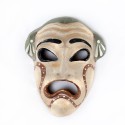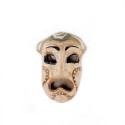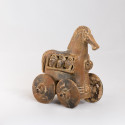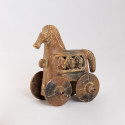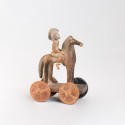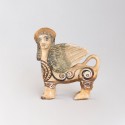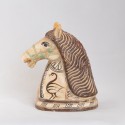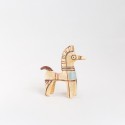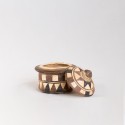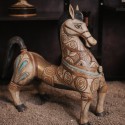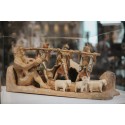
CERAMIC WOMEN'S MASK 26x 22x2.5cm - MYC053KOD1019
Copy of Ancient Greek Theatrical Mask from yellow clay reproduction about 500 b.c. Hand Made - With the Full Meaning of the the Word. Unique Artificial Aging - Museum Copy 26x 22x2.5cm
Price: 59.00€
In Greek mythology, Medusa (/mɪˈdjuːzə, -sə/; Μέδουσα "guardian, protectress") was a monster, a Gorgon, generally described as a winged human female with living venomous snakes in place of hair.
Those who gazed upon her face would turn to stone.Medusa was beheaded by the hero Perseus, who thereafter used her head, which retained its ability to turn onlookers to stone, as a weapon until he gave it to the goddess Athena to place on her shield.
In classical antiquity the image of the head of Medusa appeared in the evil-averting device known as the Gorgoneion.
Ancient Greek Theater masks.
The Ancient Greek term for a mask is "prosopon" (lit., "face") and was a significant element in the worship of Dionysus at Athens.
The ancient Greek drama was a theatrical culture that flourished in ancient Greece from 700 BC.
The city-state of Athens, which became a significant cultural, political, and military power during this period, was its center, where it was institutionalised as part of a festival called the Dionysia, which honored the god Dionysus.
Tragedy (late 500 BC), comedy (490 BC), and the satyr play were the three dramatic genres to emerge there.
Athens exported the festival to its numerous colonies.
MODERN CERAMIC ART INFLUENCED FROM THE ANCIENT GREEK CIVILIZATION
The Not Excavated Yet collection consists of ceramic artefacts which are made with a unique method that makes them look really and genuinely old.
This persuasive presentation set by itself a decorative suggestion of extensive use.
Under the correct lighting and proper display these artefacts are transformed and look imposing, pleasing, even amusing and, above all, unique pieces of art. You can find Ancient Greek, Cypriot, Etruscan, Phoenician, Sumerian, Egyptian and Celtic forms and motifs combined for the creation of one single piece.
Usually, the artist is using all different kind of clay in each one artefact (white, yellow and red clay).
The temperature of the oven fire is 900-1100o C and he is using cold colours. Some times he also employs copper plating, when he needs to underline additional decorative elements.
It’s all about a completely hand made work; therefore the production is limited.
Each item is absolutely unique. They may be “look like” the ones you see in this site or in a brochure, but they are not, by any means, exactly the same.








